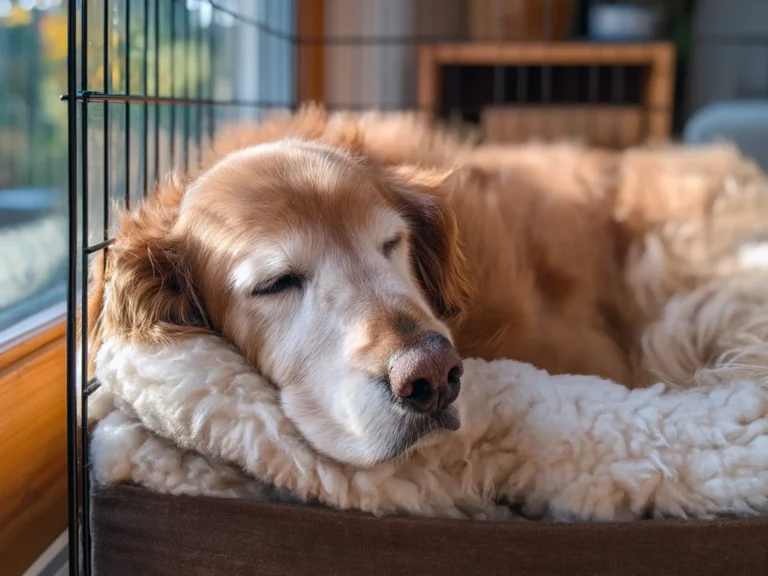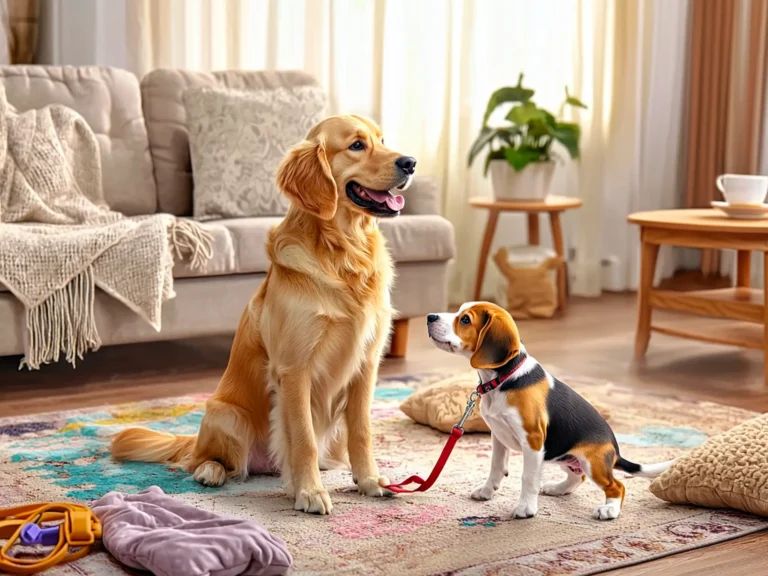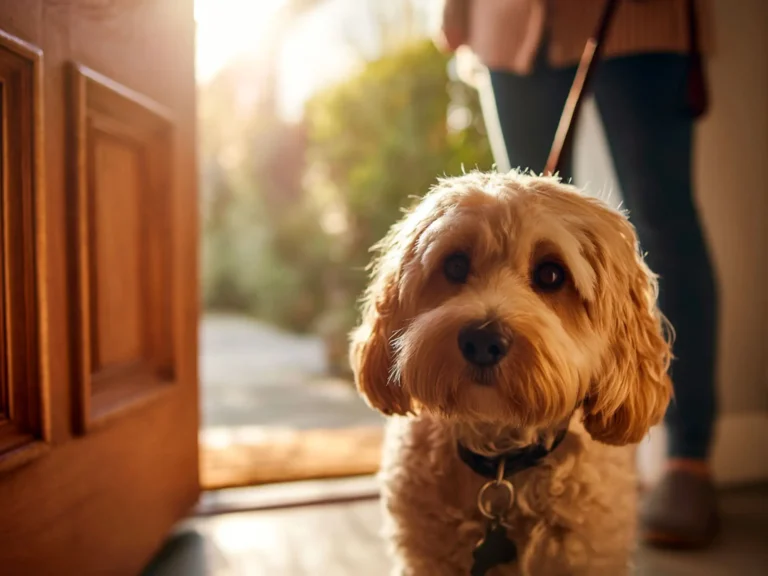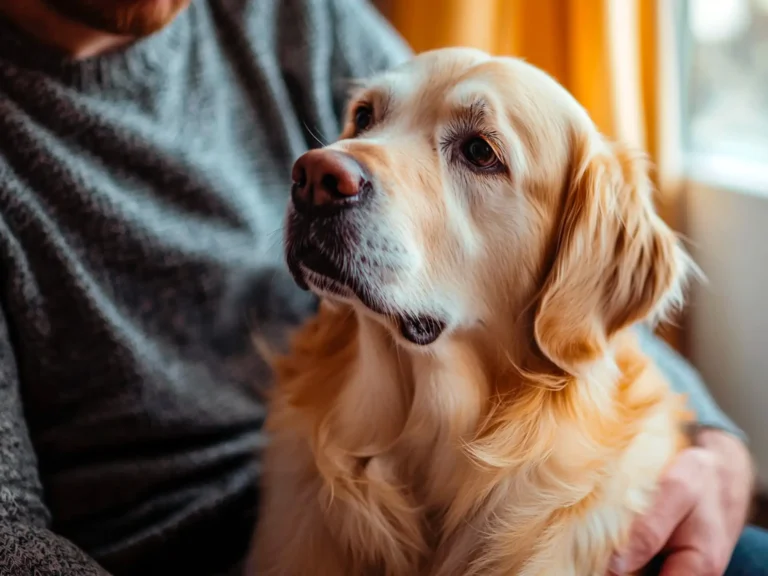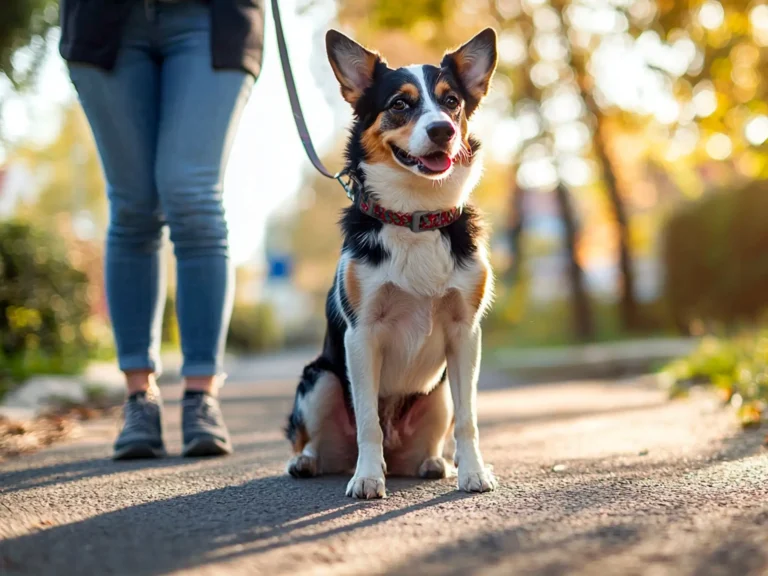Why do dogs bring you toys the moment you walk through the door? Every dog owner knows that greeting, the wiggling body, the bright eyes, and a toy proudly delivered as if it were treasure. It feels like a simple hello, but this small gesture carries a surprisingly deep meaning.
- Why Do Dogs Bring You Toys? (Quick Answer)
- They Bring You Toys to Show Love and Affection
- Instinct: Dogs Bring Toys Because of Their Ancestral Pack Behavior
- Dogs Bring You Toys When They're Overexcited or Overjoyed
- Your Dog May Be Showing Off or Seeking Attention
- Your Dog May Bring You Toys to Invite You to Play
- Dogs Bring You Toys Because They Trust You
- What Your Dog's Toy-Giving Says About Your Relationship
- When It's a Sign of Stress or Habit
- How to Respond When Your Dog Brings You a Toy
- When Toy-Bringing Might Be a Problem
- How to Encourage Healthy Toy-Giving Behavior
- Is This Behavior Normal? Here's What It Really Means
- Frequently Asked Questions
When your dog brings you a toy, they’re not just offering something to play with. They’re expressing love, trust, excitement, comfort, instinct, and sometimes even stress. It’s one of the clearest ways dogs communicate using the objects that matter most to them.
This behavior blends emotion, instinct, and learned habits into one adorable ritual. Your dog doesn’t overthink it, they feel it. The toy becomes their message: You’re home, I’m happy, and I want to connect with you.
Why Do Dogs Bring You Toys? (Quick Answer)
Dogs bring you toys to show affection, invite play, greet you, release excitement, seek attention, or express trust and comfort. This behavior can also come from instinct, learned habits, or emotional reassurance. By offering something they value, dogs strengthen their bond with you and share their happiness.
Top Reasons Dogs Bring You Toys
- Comfort or stress relief — toys act as emotional support objects.
- Affection and bonding — offering valued items shows trust.
- Greeting ritual — many dogs naturally bring objects when you come home.
- Play invitation — especially when they drop the toy at your feet.
- Attention-seeking — your reaction reinforces the behavior.
- Excitement release — grabbing a toy helps them channel big emotions.
- Instinctual sharing — rooted in ancestral pack behaviors.
They Bring You Toys to Show Love and Affection
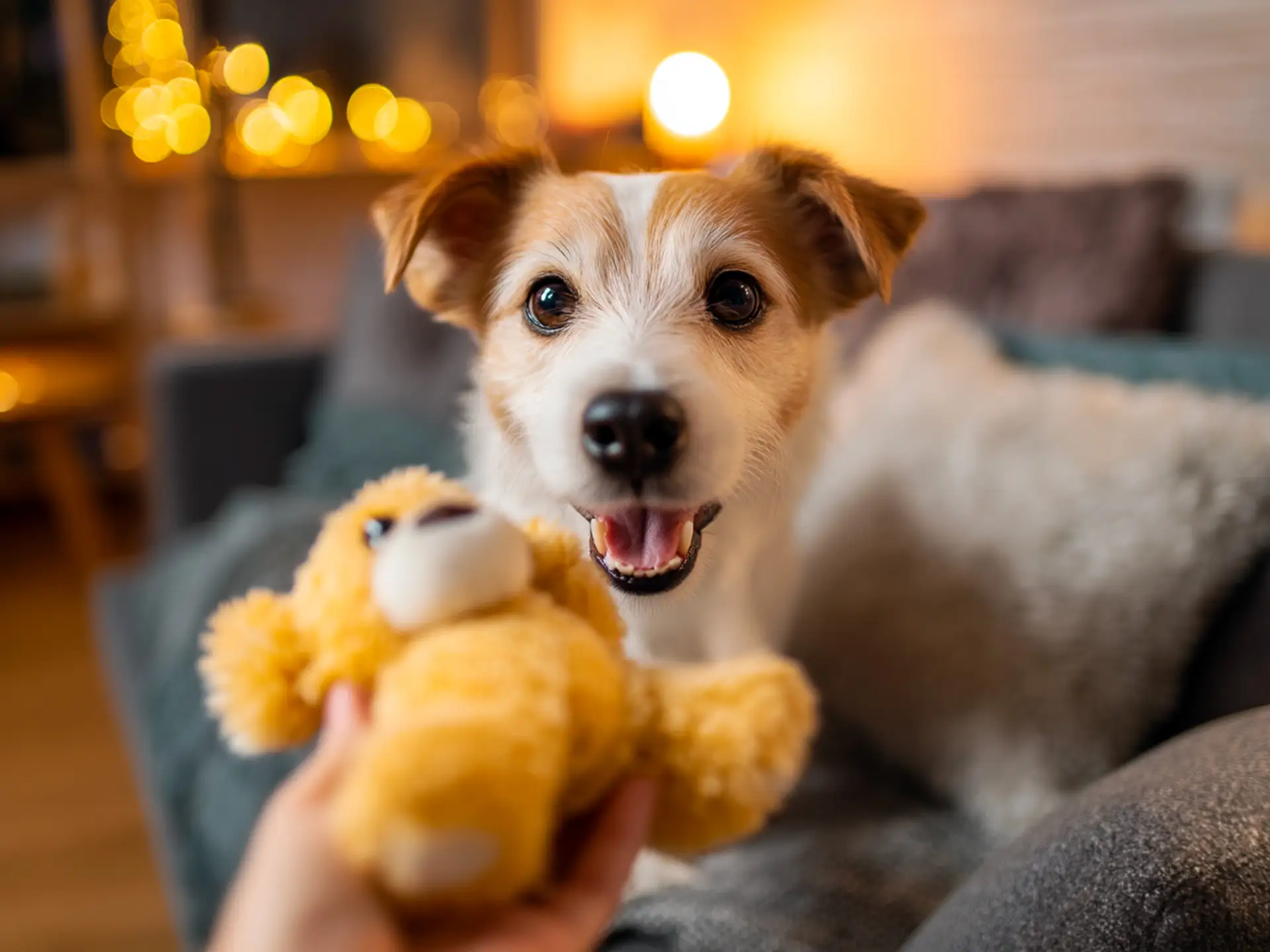
When your dog brings you a toy, it is much more than an invitation to play. It is one of the most honest ways they can show love. Dogs rarely give up what they value. If your dog walks over with their favorite squeaky duck or rope, that act carries emotion. It means they feel close to you. It means you are part of their pack.
Many people believe their dog just wants a game of fetch. In truth, this behavior is often about sharing joy and comfort. The toy they choose smells like home and safety. By offering it, your dog is extending those feelings to you. It is a small but powerful gesture that says, “I trust you.”
Researchers have found that when dogs interact affectionately with their owners, both brains release oxytocin, the same hormone that connects parents with children. This means that when you smile and take the toy, your dog feels loved in the same way a person might after a hug (see this study on the “oxytocin-mediated positive loop between dogs and humans” for the scientific evidence).
If your dog always brings you the same toy, it is not a coincidence. That object has meaning to them. It might remind them of playtime, comfort, or even security. Sharing it with you is an emotional exchange that says more than any bark ever could.
Behavior experts note that dogs often use toy-sharing as a form of social bonding. Many dogs engage in resource sharing with people they trust, especially bringing their favorite toy as a “gift” or invitation to play when the object carries their scent or strong emotional attachment. When your dog selects a specific toy for you, it’s often their way of deepening your bond.
Instinct: Dogs Bring Toys Because of Their Ancestral Pack Behavior
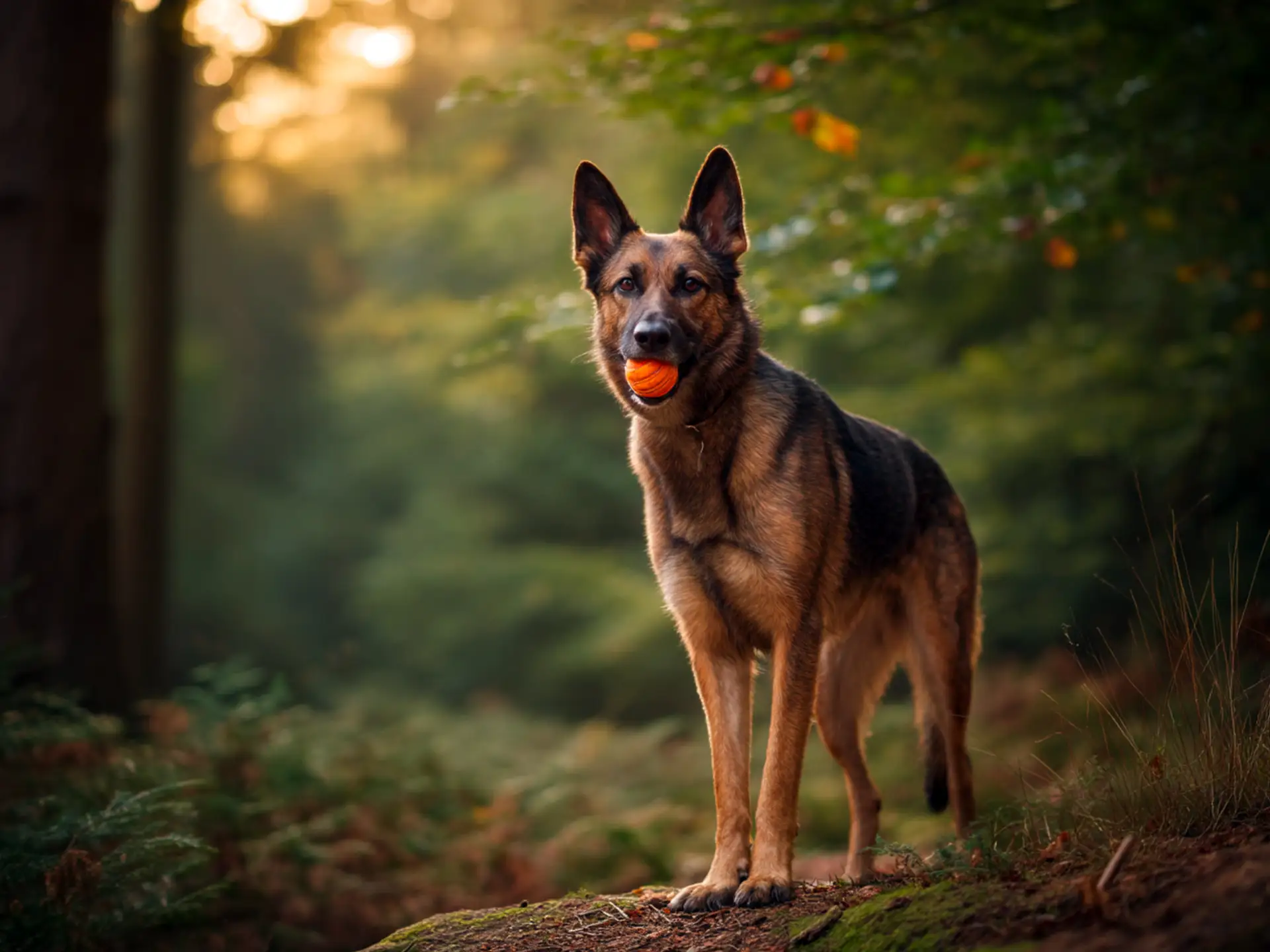
A Glimpse Into Their Wild Past
To understand why dogs bring you toys, we need to look back to their ancestors. Long before they became our companions, dogs lived as wolves in tightly bonded packs. Sharing food or objects helped maintain harmony within the group. Offering something valuable showed loyalty and reinforced trust between pack members.
That same instinct still lives inside your dog. When they carry a toy to you, they are following an ancient social code. It may no longer involve meat or bones, but the meaning is unchanged. The act of offering is a gesture of respect and unity.
A Ritual of Trust and Belonging
Modern dogs may sleep on couches instead of dens, yet their instincts remain powerful. Bringing you a toy mirrors what their ancestors did for the pack leader. It says you are part of their circle, someone worthy of gifts. Every time your dog drops a toy at your feet, they are expressing belonging and emotional safety.
You might notice that some dogs test your reaction before letting go. Others parade proudly, showing off their treasure without truly giving it up. Both behaviors stem from the same origin. They want your acknowledgment and approval. In the canine world, recognition from a trusted leader is everything.
The Connection That Still Holds Today
This ancient behavior has simply adapted to modern life. The pack leader has become the family, and the object of value has become a squeaky plush. But the meaning is still about connection. It is proof that even after thousands of years of evolution, your dog still feels the need to share, communicate, and belong.
Modern dogs do retain many ancestral social behaviors, such as cooperation, greeting rituals, and maintaining social bonds, but they are not natural resource-sharers. In fact, both wolves and dogs tend to guard valuable items rather than give them away.
So when your dog brings you a toy, it isn’t “sharing” in the human sense. Instead, it reflects a social gesture: they are expressing trust, seeking interaction, or using the object as part of a greeting ritual that evolved from cooperative pack behavior, not from resource distribution.
Dogs Bring You Toys When They’re Overexcited or Overjoyed
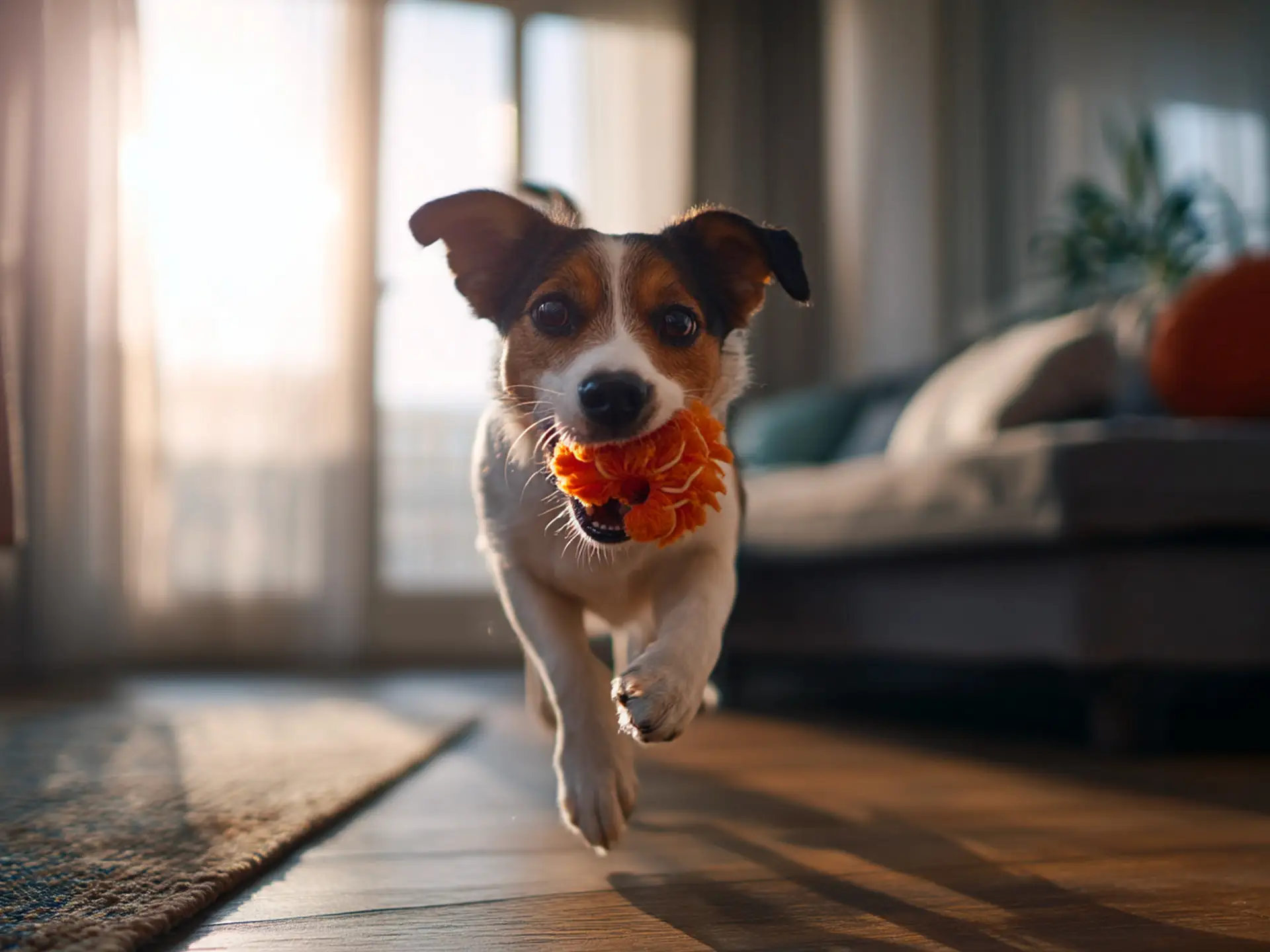
Why Dogs Bring You Toys When They’re Overjoyed
Sometimes the answer to why dogs bring you toys is pure emotion. When you walk through the door, their heart races, their tail wags out of control, and their body can barely contain the joy. In that rush of excitement, many dogs grab the nearest object in sight. It helps them channel that overwhelming energy into something familiar and comforting.
The Psychology Behind It
Grabbing a toy during a greeting is similar to how some people fidget or laugh when they feel emotional overload. The toy becomes a tool to manage energy and excitement. It keeps their mouth busy and helps them greet you politely instead of jumping or barking excessively.
Common signs of excitement-based toy giving
- The dog runs in circles before presenting the toy
- The tail moves rapidly while they hold it
- They often don’t drop the toy, preferring to prance around proudly
This version of the behavior is less about offering and more about celebration. You returning home is the best part of their day, and the toy simply becomes part of the ritual.
How to Respond
The best way to reinforce this behavior is through calm affection. Speak softly, kneel to their level, and gently pet them while they hold the toy. This keeps the excitement positive without making them hyper.
Many trainers explain that grabbing a toy is also a healthy replacement behavior. Instead of jumping, nipping, or barking, your dog channels their excitement into something appropriate. This is why professionals often encourage owners to keep suitable greeting toys near the door.
According to Pennsylvania SPCA animal advocate Carol Erickson, as quoted by CBS News:
“To stop dogs from jumping up when you walk in the door, Erickson recommends throwing some treats on the ground or grabbing a toy for your dog before they start jumping.”
Your Dog May Be Showing Off or Seeking Attention
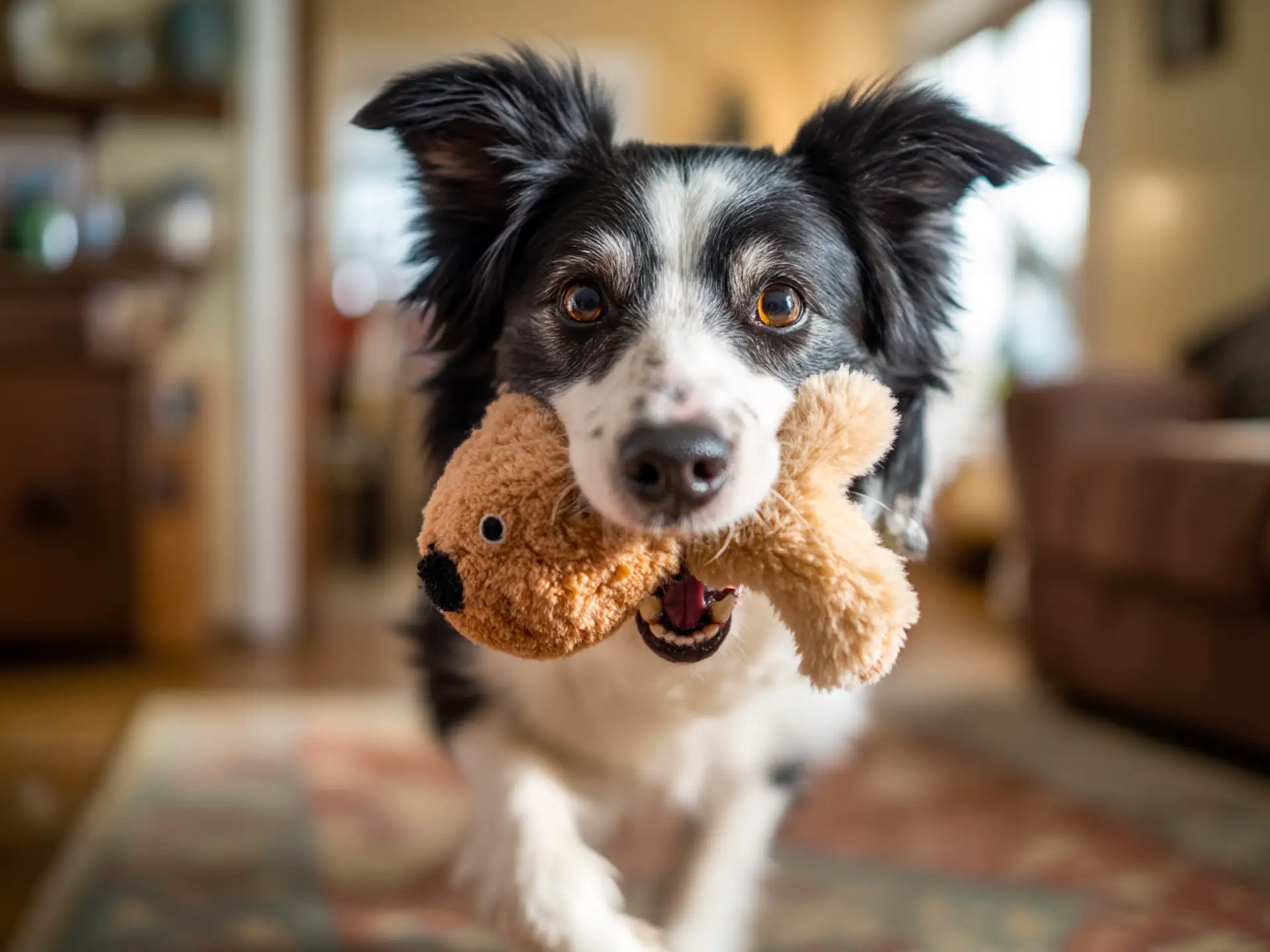
Pride Wrapped in Fur
Sometimes the reason dogs bring you toys has nothing to do with sharing or playing. It is about pride and confidence. Your dog knows when they have something good, and they want to make sure you see it. When they enter the room with a favorite plush or ball in their mouth and a sparkle in their eyes, it is not always a gift. It is a performance.
This behavior often appears in dogs that are playful or self-assured. They hold the toy high, walk slowly, and stay just out of reach. They want you to watch. You are the audience, and they are the star.
Why Dogs Love to Show Off
Dogs thrive on your attention. When you laugh, smile, or speak to them with warmth, it reinforces that behavior. Over time, they learn that showing off their toy makes you happy. For a dog, your approval is the ultimate reward.
Some dogs are selective about which toys they display. They often choose the ones that mean something to them, either because of scent, texture, or memory. These items feel special, and showing them off feels like sharing a secret they are proud of.
Typical signs of show off behavior
- The dog walks slowly while holding the toy where you can see it
- They wag their tail and look directly at your face for a reaction
- They pull the toy back if you try to take it, as if teasing you playfully
How to Respond
The best reaction is to acknowledge their pride. Speak softly, smile, and let them enjoy being noticed. When you meet their gaze and show affection, it deepens their trust. For a dog, that small moment of attention is more meaningful than a long game of fetch.
Avoid forcing play if your dog clearly wants to keep their toy. Let them bask in the spotlight they created. It is their way of saying that they feel joyful, confident, and proud to have something worth showing.
Some dogs learn that presenting a toy earns immediate attention, smiles, or praise. Over time, this creates a reinforcement loop, a concept widely referenced in dog training: the dog repeats the behavior because your reaction feels rewarding.
Your Dog May Bring You Toys to Invite You to Play
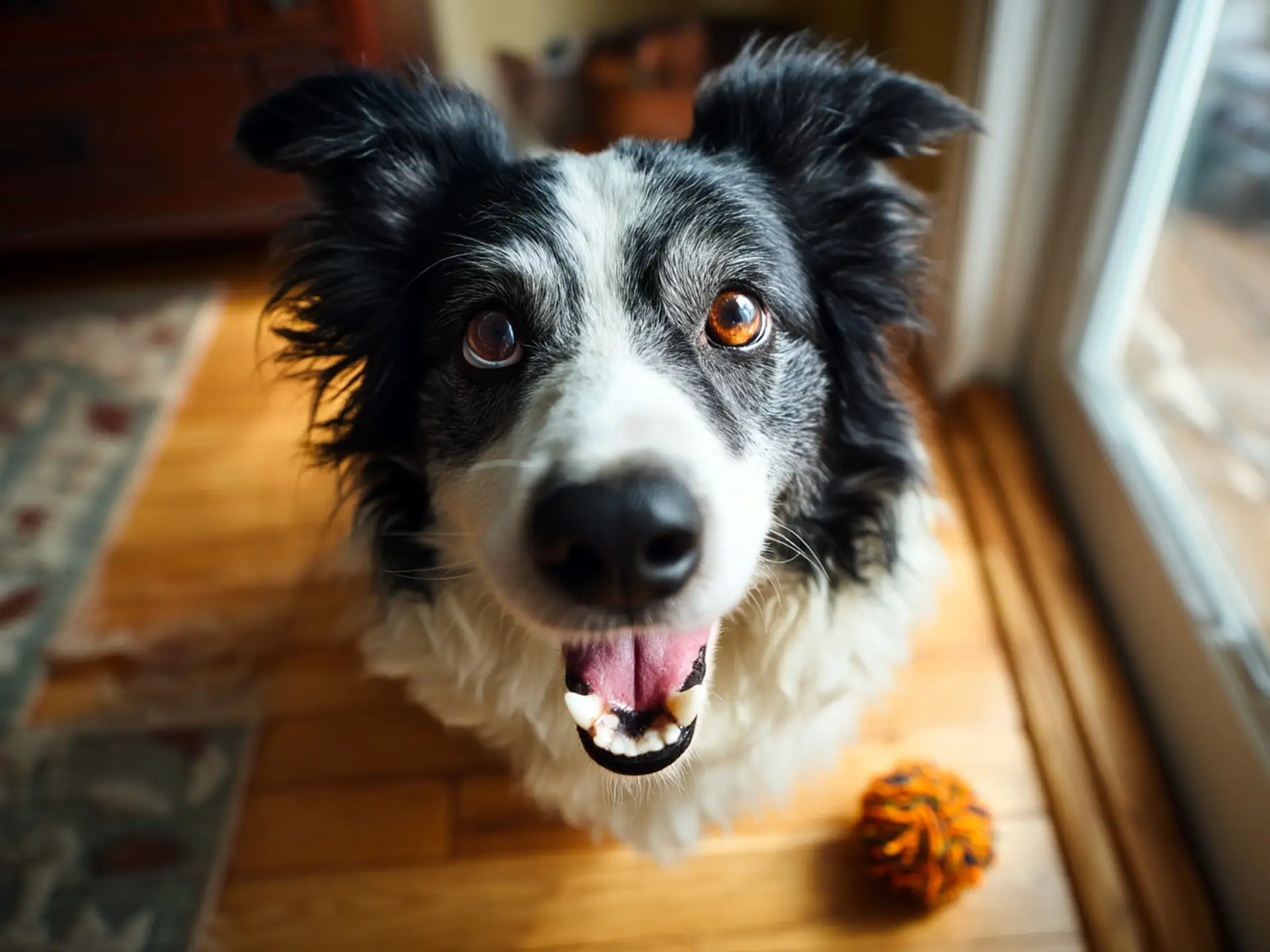
When a Toy Means Playtime
Not every time your dog brings you a toy is about affection or pride. Sometimes, it is a direct invitation to play. Dogs are masters at reading body language, and they expect us to do the same. The trick is learning to recognize the small cues that tell you what kind of gesture it really is.
When your dog brings you a toy and then drops it at your feet, that is a clear sign. They are inviting interaction. Their tail may wag quickly, their eyes stay locked on yours, and they may crouch slightly as if ready to run. Everything in their body says, your turn.
Common Play Invitation Signals
|
Behavior |
Likely Meaning |
|---|---|
|
Drops toy at your feet |
Clear request for fetch or tug of war |
|
Nudges toy toward you |
Encouragement to engage |
|
Holds toy firmly and backs away |
Invitation to chase |
|
Bows with toy in mouth |
Play bow showing friendly excitement |
|
Whines softly while wagging tail |
Request for attention or playtime |
These signals may look different from one dog to another, but the intention is the same. They want a moment of shared joy.
Many behaviourists note that dogs often use objects as part of their play-solicitation sequence. Research shows that the “play-bow” is a reliable signal to a partner (dog or human) meaning let’s play. Some trainers extend this to toy-presentation: if a dog drops a toy at your feet while in a relaxed posture with wagging tail, the intention is likely interactive play rather than possession.
When the Message Is Mixed
Some dogs combine signals from multiple motivations. They may bring the toy to show pride, then shift into play mode when you respond. Others hold it in their mouth but never release it. That often means they are excited but unsure if you want to join.
Observing the context helps you tell the difference. If it happens when you first arrive home, the behavior may be more emotional than playful. If it happens when you are already relaxed together, it is probably an invitation.
The Best Way to Respond
When you recognize a play signal, respond with enthusiasm but balance it with calm energy. Encourage your dog without overwhelming them. Use a cheerful tone, make eye contact, and take part in their world for a moment. For a dog, those few minutes of connection are everything.
Dogs Bring You Toys Because They Trust You

The Meaning of a Shared Possession
When a dog brings you their favorite toy, they are offering something that holds emotional value. That toy carries their scent, their memories, and their comfort. To your dog, it represents safety and happiness. Sharing it with you is not a small act. It is a gesture of deep trust.
Dogs do not give their treasured possessions to just anyone. When they place that squeaky ball in your lap or rest it beside you, they are saying, I feel secure with you. It is a moment of vulnerability that reflects their bond with you.
What Science Says About Trust
Animal behavior studies show that dogs experience a release of oxytocin when interacting positively with their owners. The same hormone that strengthens human attachment strengthens the bond between you and your dog. When they bring you their toy, their brain associates that action with safety and affection.
In simple terms, giving you a toy is how your dog shows emotional honesty. They trust that you will not take their comfort away but will appreciate the offering.
How to Recognize a Trust Gesture
|
Behavior |
What It Means |
|---|---|
|
Brings favorite toy calmly |
Deep trust and emotional comfort |
|
Lies down beside toy near you |
Feels secure and relaxed in your presence |
|
Places toy on your lap without excitement |
Sharing rather than seeking play |
|
Avoids letting strangers take toy |
Strong selective attachment to you |
How You Can Reinforce That Trust
Respond gently and kindly. Smile, pet them softly, or thank them with a calm voice. You do not need to start a game every time. What matters is acknowledging the moment. When your dog sees your appreciation, it strengthens their confidence in you.
Over time, this small ritual becomes one of the quiet ways your dog says that they belong to you and you belong to them. It is love expressed in the simplest possible form — the gift of a toy.
Animal behavior experts note that when dogs approach calmly with a valued toy, it mirrors secure attachment behavior rather than resource sharing. Studies on the dog–human bond show that positive interactions trigger oxytocin release in both species, strengthening emotional security. A dog who brings you a meaningful object often feels safe, connected, and deeply bonded.
What Your Dog’s Toy-Giving Says About Your Relationship

A Reflection of Your Relationship
When your dog brings you a toy, it reveals more about your bond than most people realize. Dogs are honest communicators. They do not hide their feelings or pretend to be polite. Every gesture has meaning, and this one is full of emotion. A dog that offers you a toy is showing how they see you. It means safety, comfort, and genuine affection.
The consistency of this behavior can tell you how your dog feels about your relationship. If they greet you with a toy every time you return home, it shows anticipation and happiness. If they quietly rest their toy near you, it shows calm attachment. Each version of the gesture speaks a slightly different emotional language.
Emotional Layers Behind the Habit
There is a reason this small action touches people. It is the perfect mix of instinct and love. Your dog is using a natural behavior that once bonded pack members in the wild, but they now use it to bond with you. It is a reminder that they see you as their person, someone who brings stability and care.
Dogs that feel secure in their environment display more positive social gestures, including toy sharing. It means they do not just rely on you for food or shelter. They rely on you for connection. You have become part of their emotional world.
How to Strengthen That Bond
The next time your dog offers you a toy, respond with calm enthusiasm. Smile, make eye contact, and give them a gentle touch or kind word. When you mirror their affection, you reinforce their confidence in your relationship.
Creating short moments of shared attention strengthens trust and mutual understanding. It does not require training or treats. It requires presence.
Your dog does not bring you a toy for no reason. They bring it because, in their mind, love is something to share.
If your dog consistently brings toys during calm moments, not just during excitement, it can indicate a strong secure attachment style, a concept recognized in canine behavioral research. These dogs use toys as a way to check in emotionally, reaffirming their connection to their favorite person.
When It’s a Sign of Stress or Habit
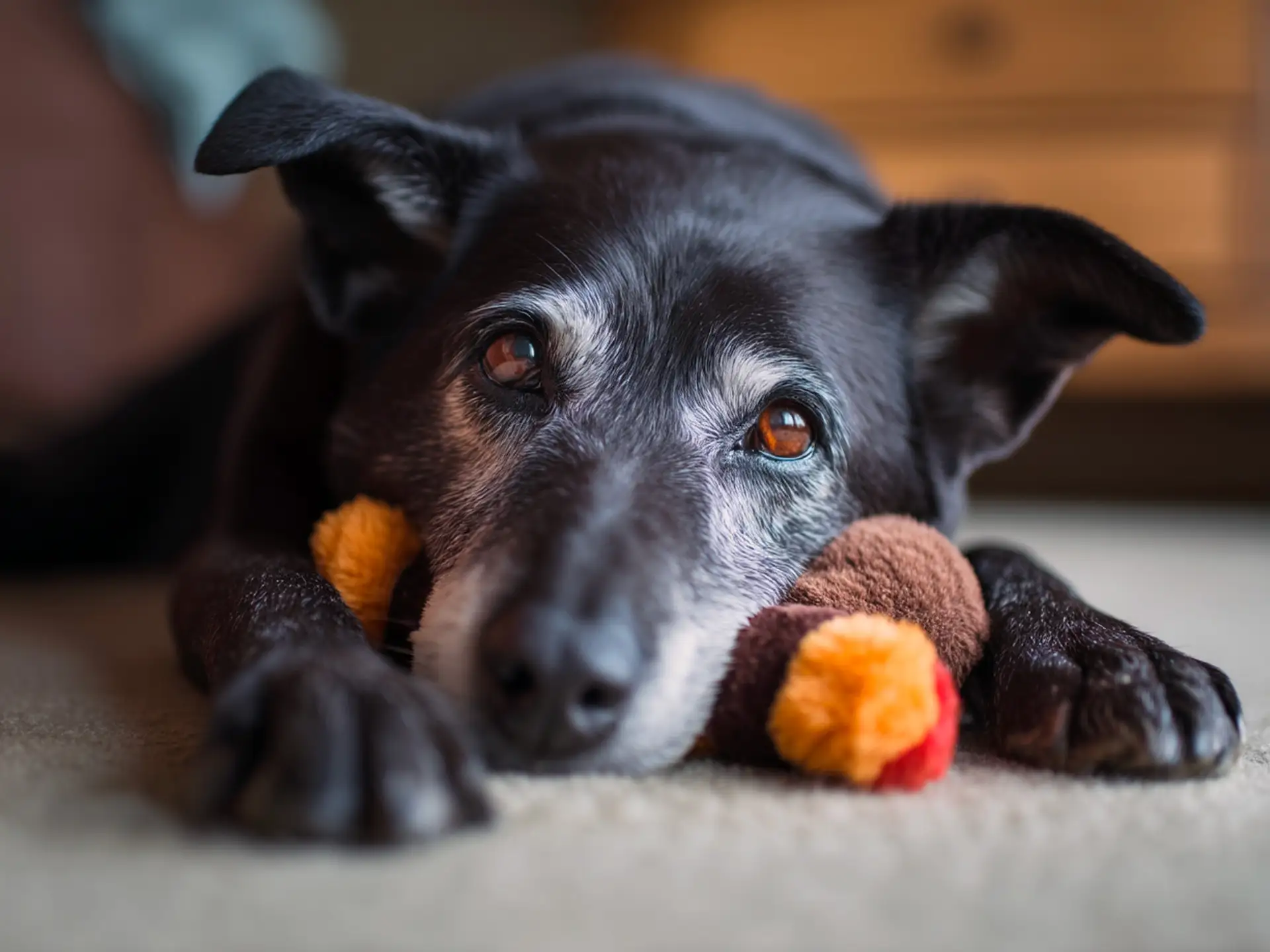
Understanding the Difference
While bringing you a toy is usually a positive gesture, sometimes it can come from stress or insecurity. Dogs use familiar objects to comfort themselves when emotions feel overwhelming. A favorite toy can serve as a coping mechanism, just like a child clinging to a blanket.
If your dog repeatedly brings you the same toy but seems uneasy or restless, it might not be excitement. It might be their way of seeking reassurance. This is common in dogs that struggle with separation anxiety or changes in their environment.
Recognizing Signs of Emotional Distress
Look closely at your dog’s overall behavior when they bring you their toy. If the gesture feels tense rather than joyful, there may be more going on beneath the surface.
|
Behavior |
Possible Meaning |
|---|---|
|
Whining while offering toy |
Seeking comfort or reassurance |
|
Restless pacing with toy in mouth |
Anxiety or nervous energy |
|
Repeatedly dropping toy without play signals |
Habitual or stress-related action |
|
Bringing toy and refusing to play |
Need for attention or emotional security |
Stress-related toy-giving is more common in dogs experiencing separation anxiety, lack of mental stimulation, schedule changes, or environmental stressors. If your dog paces with a toy, whines, or repeatedly offers it without engaging in play, it may be a coping mechanism rather than a joyful gesture. In some cases, repetitive toy presentation can also resemble displacement behavior, where a dog uses familiar objects to self-soothe during emotional conflict.
How to Respond with Care
If you suspect your dog is using toys to soothe themselves, the best response is calm reassurance. Avoid scolding or ignoring them. Instead, offer gentle affection and create a peaceful environment. Encourage structured play sessions when they feel relaxed, but do not force them into activity.
Provide regular routines, exercise, and quiet companionship. Dogs thrive on stability. When they know what to expect, their emotional need for constant reassurance often fades.
A dog that uses toys for comfort is not misbehaving. They are communicating the only way they know how. By paying attention and responding with patience, you help them rebuild confidence and security.
If the behavior becomes obsessive, interrupts daily routines, or appears alongside symptoms like destructive chewing, shadowing, or excessive vocalization, consult your veterinarian or a certified behaviorist. These professionals can determine whether the toy-giving is linked to anxiety or a developing compulsive pattern.
How to Respond When Your Dog Brings You a Toy
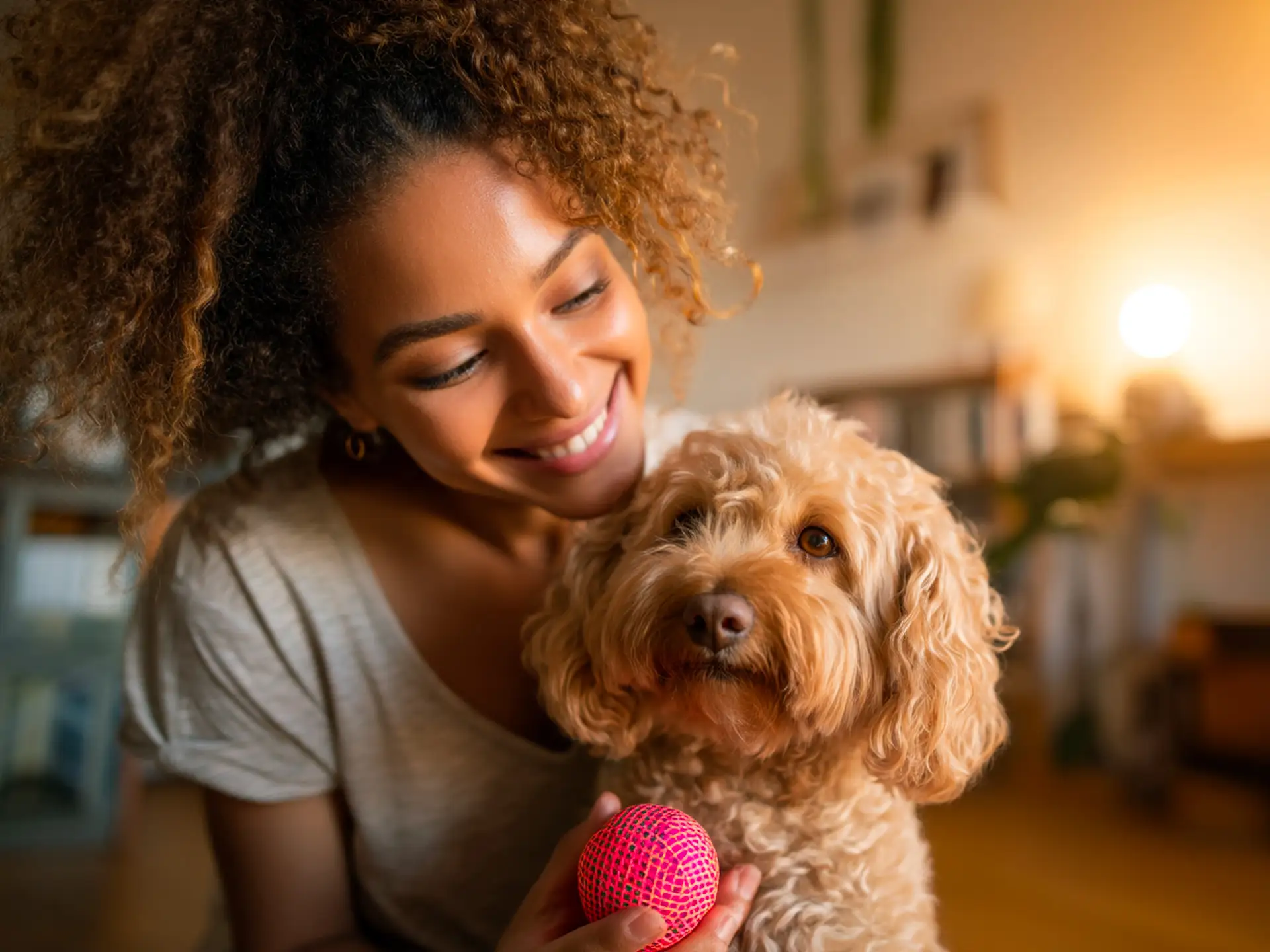
Listening Beyond the Gesture
When your dog brings you a toy, what they want most is acknowledgment. They are communicating, and how you respond shapes the trust between you. The key is to recognize the emotion behind the action before reacting. Sometimes they want to play, sometimes they want attention, and sometimes they are simply saying hello in their own way.
Dogs are deeply social animals. Ignoring their attempts to connect can leave them feeling unseen. A small response, even a smile or a few words, tells them that their effort matters. It reassures them that you understand their language.
Ways to Respond Positively
A calm, consistent reaction helps your dog feel secure and confident. You do not need to turn every interaction into a game, but you should always show appreciation for their gesture.
Best responses when your dog brings a toy
- Smile or speak softly to let them know you see and value their effort
- Pet them gently while they hold the toy to create a moment of connection
- Engage in play if their body language shows energy and excitement
- Say thank you or good job to reinforce trust and understanding
- Avoid taking the toy abruptly, as it can feel like rejection
These small acts tell your dog that their communication worked. They build a stronger emotional bridge between you and your companion.
When to Redirect Gently
If your dog brings toys too frequently, it might mean they crave more structured playtime. Establish regular routines for exercise and interaction. This helps them learn when playtime happens and reduces the need for constant attention-seeking.
Redirect excess energy through training games or short walks. The goal is not to stop the behavior but to guide it toward balance. When your dog knows you will always respond at some point, they learn to relax and trust the rhythm of your day.
The Reward of Connection
Your dog does not measure affection in gifts or words. They measure it in moments. Every time you pause, make eye contact, and respond with kindness, you strengthen their sense of belonging.
So the next time a well-loved, soggy toy lands at your feet, do not see it as clutter. See it as love made visible.
Dog trainers recommend responding based on your dog’s intention. If the gesture is playful, interacting for even a few moments can satisfy their need for connection. If the gesture is calm and affectionate, simply acknowledging your dog with gentle praise can reinforce emotional security. The key is to avoid unintentionally reinforcing attention-seeking loops, where the dog brings toys nonstop because they receive intense reactions each time.
When Toy-Bringing Might Be a Problem
While toy-giving is usually a positive and sweet behavior, there are moments when it may signal something deeper than affection or excitement.
Possible Red Flags
- Your dog seems tense or anxious while offering the toy
- They pace or whine with the toy in their mouth
- They bring toys repeatedly and won’t settle
- They refuse to play even when encouraged
- They guard the toy or seem conflicted about letting it go
- The behavior suddenly appears after a major change (new home, new baby, schedule changes)
Some dogs use toys as coping mechanisms when they’re stressed, overstimulated, or unsure how to express their feelings.
When to Seek Help
You may want to consult a veterinarian or certified behaviorist if:
- The behavior interrupts daily routines
- Your dog becomes overly dependent on the toy
- Toy-giving appears alongside destructive chewing, pacing, vocalizing, or clinginess
- Your dog won’t sleep, relax, or move around the house without carrying a toy
- The toy presentation seems obsessive or compulsive
Early support can prevent small emotional struggles from becoming long-term anxiety.
How to Encourage Healthy Toy-Giving Behavior
Toy-giving can be a wonderful, enriching part of your dog’s communication. Here’s how to support it in a healthy way:
- Rotate toys to keep things exciting and mentally stimulating
- Offer play when your dog clearly invites it
- Reward calm toy-giving with gentle praise or affection
- Avoid grabbing toys abruptly, which can create tension
- Create structured play sessions every day to help release energy
- Place greeting toys near the door to redirect jumping and barking
- Teach “give” or “drop it” to improve communication and reduce confusion
Healthy toy rituals help your dog feel understood, confident, and emotionally connected. They also create predictable, positive interaction patterns that strengthen your bond.
Is This Behavior Normal? Here’s What It Really Means
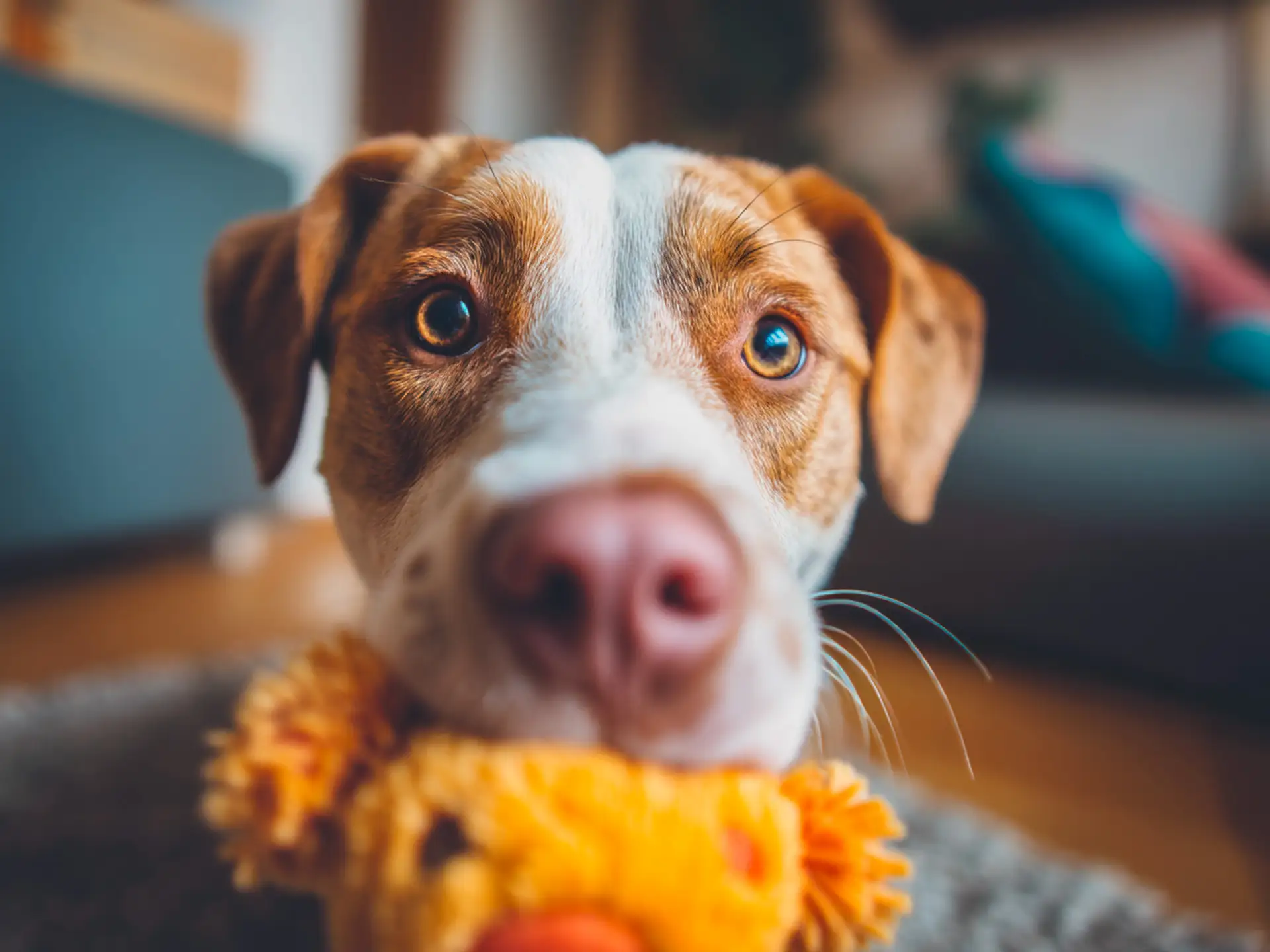
A Simple Act That Means Everything
When you look at your dog proudly holding a toy in their mouth, it is easy to underestimate the meaning behind it. Yet this small ritual captures everything that makes the bond between humans and dogs so extraordinary. It is loyalty, trust, joy, and connection all in one gesture.
Your dog may not have words, but they have intention. Every time they bring you their favorite toy, they are offering more than a squeaky object. They are offering a piece of their happiness. It is their way of saying that you matter, that they feel safe with you, and that you make their world whole.
Why This Behavior Deserves Attention
Behaviorists often describe toy gifting as one of the clearest expressions of canine affection. It blends instinct and emotion in a way that is uniquely doglike. It reminds us that love does not always need grand gestures. Sometimes, it looks like a slobbery plush rabbit placed gently on your lap.
If you respond with warmth, you reinforce what every dog longs to feel: connection and belonging. That is why this moment, repeated across millions of homes, never loses its power. It is the heartbeat of companionship.
Cherish the Gesture
So the next time you step through the door and your dog greets you with that familiar toy, pause for a second. Take in the wagging tail, the shining eyes, the quiet pride. Smile and accept the gift.
Because what you are holding is not just a toy. It is love, loyalty, and a little bit of drool wrapped in fur.
Most canine behavior experts classify toy-giving as a normal, healthy social behavior. Whether the reason is excitement, bonding, play, or habit, it’s usually a sign of a secure and positive dog–owner relationship.
Frequently Asked Questions
Why does my dog bring me toys but not let me take them?
Your dog may be showing off rather than offering the toy. Many dogs enjoy displaying prized objects but prefer to keep possession. This behavior is typically about confidence, attention-seeking, or pride, not play. It’s normal as long as your dog remains relaxed.
Why does my dog bring me toys when I come home?
This is a common greeting ritual. Dogs often grab the nearest object to channel excitement and avoid jumping or barking. Bringing a toy helps them release emotion and creates a positive way to welcome you back into their social group.
Why does my dog bring me toys and cry?
Crying while bringing a toy usually signals mixed emotions — excitement paired with uncertainty or a desire for reassurance. Many dogs vocalize when their feelings are intense. If the behavior appears stressed or repetitive, it may relate to anxiety rather than play.
Why does my dog bring me random objects instead of toys?
Dogs sometimes grab shoes, socks, or household items because they smell like you. These objects provide comfort and may be closer at hand than toys. It’s usually harmless, but offering structured play and accessible toys can reduce unwanted object retrieval.
Is it normal for dogs to bring toys to strangers or guests?
Yes, some dogs bring toys to show friendliness or initiate social interaction, even with unfamiliar people. However, shy or anxious dogs typically only present toys to trusted individuals. Watch body language — wagging and relaxed posture indicate healthy social behavior.


